Rather than paying the ridiculous prices many dive shops want for SCUBA lead, I decided to make my own. Yes, casting your own lead is rather dangerous. Hence why you should do it in a well-ventilated area while wearing proper barriers and respirators. In short, don’t breathe the stuff and don’t get it on you. Wash all of your clothes or even throw them away after being in contact with lead or lead fumes. FOLLOWING ANYTHING I TALK ABOUT ON HERE IS AT YOUR OWN RISK. I take no responsibility for anything you might do to hurt yourself or others. If you don’t know what you’re doing, don’t do it. Spend the money on some pre-made SCUBA lead!
The first and probably hardest part of the whole operation is acquiring cheap lead to melt. I found mine through a friend who happened to have a 100 pound chunk of lead used in ocean anchors and ship ballasts. In other words, it was already alloyed correctly to prevent the lead corroding into lead chloride when it comes in contact with salt water.
Originally I had tried to saw the large brick of lead into smaller chunks to use directly as my weight system. That plan didn’t work so well. A little over two hours after I started hacksawing away at the block, I finished my first chunk. Yeah, that wasn’t going to work very well. Plan B was to melt and cast the lead.
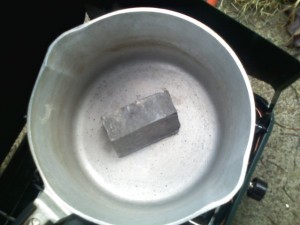
My first attempt at melting used my roommate’s two burner Coleman stove. After about an hour of heating, it still hadn’t quite melted. The lead was definitely soft but it wasn’t liquid. I pulled out my trusty Camping Gaz stove and fired it up. A few minutes later I had a happy pot of melted lead.
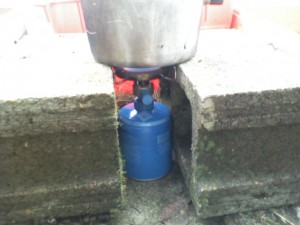
Before I go any further I should make a note of the types of pots and molds I am using. Rather than buy some fancy crucible and molds, I went to a local thrift shop. For a couple of bucks, I picked up an old cast aluminum pot with lid and a cast aluminum muffin tin. Aluminum’s melting point is about double that of lead making it perfect for the application. Cast iron, stainless steel, and other such materials can be used. However, be careful of pots that have coatings. They’ll probably burn off and could screw up your lead. Remember: anything that you use to melt and cast lead with is no longer safe to be used in the kitchen!
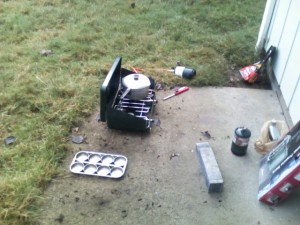
Since casting my first batch of SCUBA weights, I’ve learned that some people cast small weights in the bottom of pop cans. The cans don’t melt and make beautiful forms. They are especially good for making lead weights for bottom fishing as well.
The first pour turned out quite nice. Before I dumped the lead into my muffin tin, I coated the inside with some old motor oil I had laying around. No clue if it was necessary or not but it did seem like they came out very easily.
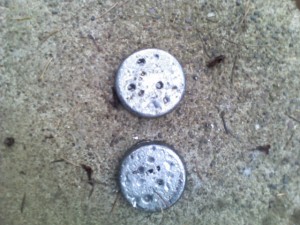
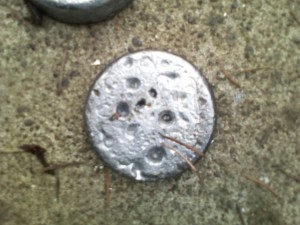
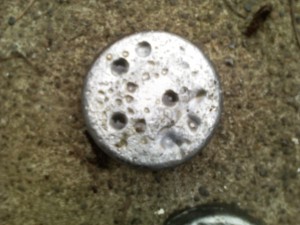
In a fit of pure madness, I decided that it was time to step up efforts and attempt to melt the rest of the 100 pound block of lead… all at once. In hindsight, I should have taken the time to split it into several 15 or 20 pound chunks. Not only is it very hard to pour out of a pot when it contains 100 pounds of lead, it is also very difficult to actually make that lead melt.
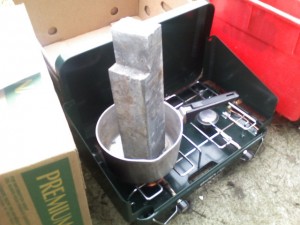
The Coleman stove was employed to try to heat the lead to near melting before I was to switch to the Camping Gaz stove. This is another important point. Always ALWAYS make sure you have enough fuel before you start heating lead. There is nothing worse than almost being to the melting point and running out of gas. My Camping Gaz canister was running in that direction. After waiting for the lead block to melt for several hours, I decided that I should just switch to the other stove.
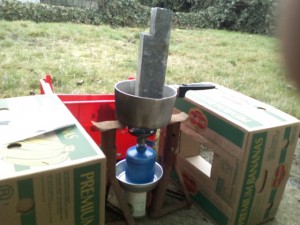
At first, I tried to support the whole mess with car jack stands. That didn’t go so well. When the block started to melt, it tipped and dumped the whole thing on the ground. Oops. I finally found some cinder blocks that I could rest the pot on.
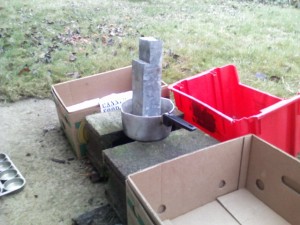
Another hour of heating passed and it still hadn’t quite melted enough to pour. That hour of heating also used up the last of the gas cylinder. No where was open in town that sold the canisters for my Camping Gaz stove. I was forced to switch back to the Coleman.
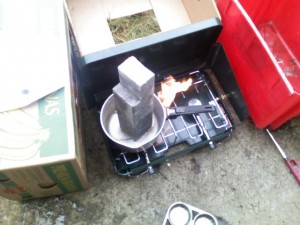
At this point, brilliance struck. I grabbed a roll of tin foil and started insulating the heck out of the pot and lead block. Many layers later, it looked like a little silver mountain. That did the trick. Even on the Coleman stove, I managed to get about half the block of lead to melt down enough to pour. The trick, you see, is to hold as much heat in the pot and in the lead as possible. Without a cover and with so much mass sticking up into the cold air, most of the heat was escaping to the environment.
While the aluminum foil setup worked well, one problem remained. My lead block only half-melted. Rather than being pure lead, this block was a lead-tin-??? alloy. The lead melted out just fine but chunks of other material were left behind. I poured the lead and left the remnants in the pot. It was late, I was tired, and I needed to dive the lead the next day. In the near future, I will be re-melting the lead I cast and combining it with the left-overs from before to make sure I have consistent, high-quality SCUBA lead that does not need treatment.
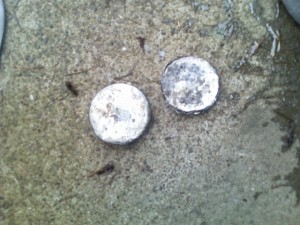
All in all, I would say that my lead casting experiment was a success. The muffin tin produced perfect little 3-4 pound weights with no sharp edges that slip nicely into my BCD weight pouches and my weight belt. After about 30 dives on the lead, it still looks in good shape and hasn’t corroded. It should stand up even better to harsh marine environments once I recast with the left-over lead.
